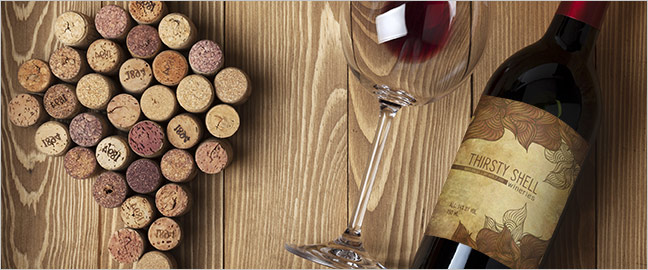- Products
-
Design Templates
- Featured Design Galleries
- More Galleries
- Services & Resources
- Free Sample Kit
- Deals

There are hundreds of different types of products sold in bottles, from beer and wine to sauces and salad dressings to iced teas and condiments. If you make your own bottled products – either in your own facility or via a vendor facility – or if you're a graphic designer who has been hired to develop visual branding for a bottled product seller, you'll quickly realize all bottles have a common need: bottle label design and printing. Learn how to properly prepare print-ready artwork for wine and bottle labels and what you need to know to print the best labels for your products in the following bottle label design and printing tips.
Start with a bottle label template The best way to ensure your bottle label design is ready for the printing press is to download a free wine and bottle label layout guideline to use as the foundation of your design. The wine and bottle label guidelines provided by PsPrint do not include any design elements; rather, they're setup and layout templates that are formatted in the correct size, resolution, and color mode for printing. In addition, the templates provide helpful guides for bleeds, cut lines, and safe areas so you can position your artwork correctly. Download your free wine and bottle label templates and place them on the bottom layer of your design file. You can then create your design on layers on top of your template, and reduce their opacity to double-check your layout – or, use the template to add layout gridlines to your design file. Either way, make sure you increase your design opacity to 100 percent and delete your template file once your design is complete. Another method is to flatten your image before exporting as a PDF or other file type: since your template layer is on the bottom, it will be hidden by the layers on top when your image is flattened.
Craft a compelling, branded design With your wine and bottle layout template in place, it's time to craft your bottle label design. Start by collecting all the design elements you'll need: logos, images, color palette, theme ideas, product name, label content, sales copy, etc. Carefully consider what the brand and individual product represent as well as the desires of the customers you're designing labels to attract. Your label design should be unique and compelling. It should be attention-getting and it should resonate with your customers. Study competing products and brands so you can make your label stand out from the crowd. Identify your competitors' shortcomings – perhaps they don't list their product benefits – and take advantage of those shortcomings through your own artwork. Your bottle label designs should be simple and easy to understand at-a-glance. They should be visually descriptive – they should set a mood, promote an attitude, convey an emotion, or otherwise speak to your customers' desire to have something, be something, or experience something. Whatever that “something,” is, your bottle label design should promise its fulfillment. After your design is complete, it's a good idea to share it with others – especially current customers – for feedback. See if customers can identify with your new product bottle labels; if it creates desire and excitement, you have a winner. It can be beneficial to design two or three alternative designs and layouts for comparison purposes; even minor tweaks such as typography settings and image placement can have huge impacts on customer perception.
Print wine and bottle labels If you've used a template to create print-ready artwork, printing wine and bottle labels is the simplest part of the process – mainly because it's largely performed by your printing company. The biggest decision you need to make at this point is your choice of label stock. There are two primary label stocks that work well for most applications: polyester bottle labels and wine “parchment” bottle labels. Polyester stock is clear, so it lets the contents of your bottles show through. You can print any label design and colors on polyester stock, which adheres well to glass, metal, plastic and other bottle composition materials. Clear polyester label stock is a good choice for products kept both on room temperature shelves and in refrigerators. Wine “parchment” bottle labels are not transparent, but they have a unique feel (like parchment paper) that adds an elegant touch. These bottle labels can be used in both and cold environments, so they're well-suited to a variety of products. You're not limited to using these bottle labels on wine bottles – they can work to brand just about any kind of bottled product. If you have an arrangement with a food processing vendor and/or bottling plant, you can arrange to have your printed bottle labels sent directly to the vendor or plant to be affixed to your bottles. This strategy will reduce overall shipping costs and streamline the entire process for greater efficiency and increased profits. Designing and printing bottle labels can be some of the most exciting work you'll ever do, whether you own the brand in question or you've been hired to craft a label design. Follow the tips in this article, and you can design and print bottle labels that are professional, well-branded, and geared to command aisle attention with minimal effort and investment.
Success! You're all signed up.